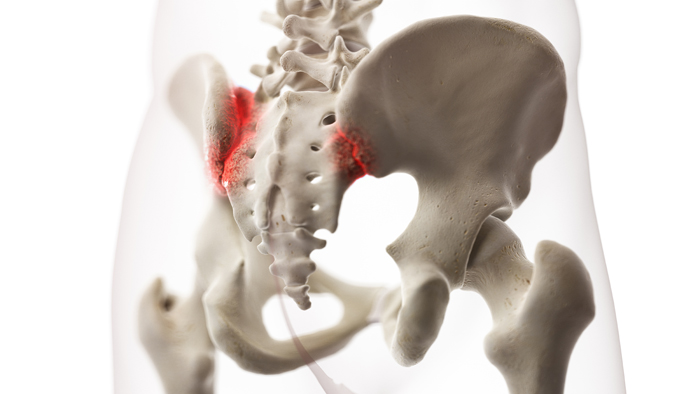Sacroiliac Joint Pain Treatment & Diagnostics in Tardeo, Mumbai
Sacroiliac Joint Pain
In the pelvic region of our bone structure, our spine is connected to our hip bones (ilium) and tailbone (coccyx) through sacroiliac joints (SIJs). The name is derived from the connection of the lowest part of the vertebrae, the ‘sacrum’ (above the tailbone), to the ilium. These SIJs support the entire weight of the upper body and the cartilage and ligaments of the pelvis.
Sacroiliac joints absorb shocks of the legs and the vertebrae while supporting weights. These joints are also responsible for maintaining stability during physical activities like walking, running, cycling, etc. A network of soft tissues and ligaments surrounding these reinforces SIJs while absorbing pressure and limiting movements.

What is sacroiliac joint pain?
Sacroiliac joint dysfunction can manifest itself through lower back pain, which can also cause leg pain along with it. The joint pain could be observed during bending forwards or backwards or during exercises that involve significant movement of the legs and leg muscles.
Depending on the extent and cause of the pain, sacroiliac joint pain can range from mild to severe. Acute SIJ pain that occurs suddenly may heal within days or weeks. Chronic SIJ pain worsens with time/strenuous activities, as it may be experienced for more than 3 months.
To seek treatment, you can search online for a pain management doctor near me or a pain management hospital near me.
What are the symptoms of sacroiliac joint pain?
The symptoms of sacroiliac joint pain are observed at the lower back and buttocks. The pain may radiate along the lower hips, upper thighs and groin region. The pain is usually observed on only one side, but sometimes it can affect both sides. Patients have also described numbness, tingling sensations or weakness in the legs due to SIJ pain.
These symptoms could get worse, during activities like sleeping, climbing stairs, walking, etc. Sleeping on the affected side or sitting could become excruciatingly painful for those with SIJ pain. The pain might peak during transitional movements of the pelvis/legs, such as climbing staircases.
What causes sacroiliac joint pain?
Since the sacroiliac joint connects the vertebrae and the pelvis through an interlock, ligaments are the only mechanism that exists to strengthen it. Some of the causes of sacroiliac joint pain and degenerative sacroiliitis are:
- Ligaments become too tight or loose
- Fall, work injury, accidents, spine surgery, etc.
- Pregnancy and childbirth
- Uneven movement of the legs
- Arthritis, with hip or knee problems
- Axial Spondyloarthritis
When do you need to see a doctor?
You should consult a sacroiliac joint pain specialist if you experience any of the symptoms of SIJ pain. If you have experienced lower back pain or aches that travel through your hips, thighs or groin, you should see a doctor, as you might require medical attention for sacroiliitis.
If you have suffered an accident, trauma, fall or a major injury in the pelvic region or if you already have an existing spinal condition, you must immediately consult a sacroiliac joint pain doctor near you.
Request an appointment at Apollo Spectra Hospitals, Tardeo, Mumbai.
Call 1860 500 2244 to book an appointment.
How is sacroiliac joint pain treated?
Depending on the exact diagnosis and severity of your sacroiliac joint pain, a doctor will treat your medical condition.
- If the pain is less intense, non-surgical treatments like physical therapy, stretching exercises or chiropractic manipulation may be recommended.
- Oral, anti-inflammatory medicines, mechanical braces, topical creams may assist in reducing the pain for some patients.
- Steroid joint injections can reduce inflammation and swelling of the nerves, as they are a minimally invasive form of treatment.
- Nerve ablations or radiofrequency ablation require electric current to destroy the pain signal carrying nerve fibres within the joint.
- Surgical procedures involving titanium metal implants and bone graft material to facilitate bone growth and stability may be recommended.
Conclusion
SIJ pain can be diagnosed through physical examination, X-rays and MRI scans. The painful medical condition of ‘sacroiliitis’ (sacroiliac joint pain) can be treated effectively, when a patient receives the right treatment.
If you experience a sharp, radiating pain that travels from your hips, pelvis to your thighs and the lower back, chances are you have sacroiliac joint pain.
Heavy exercises and workouts should be avoided at all costs. Shifting your weight unevenly on one side of your body must also be avoided
Poor exercising posture, lifting extremely heavy weights and accidental injuries can worsen your SIJ pain. Ignoring your pain, even when the symptoms are evident, can also lead to discomforting pain and numbness, which can get worse over time.
Our Doctors
DR. SURBHI P. BHAGAT
MBBS, MD - Anaesthes...
| Experience | : | 21 Yeras Experience |
|---|---|---|
| Speciality | : | Pain Management... | Location | : | Tardeo |
| Timings | : | Mon to Sat : 01:00 P... |
Our Top Specialities
NOTICE BOARD
CONTACT US
CONTACT US
 Book Appointment
Book Appointment



.svg)
.svg)
.svg)
.svg)








